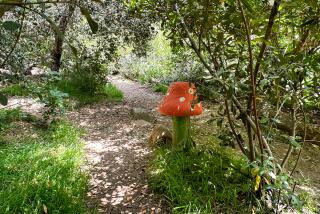The Secret Garden : A Plantsmanâs Paradise Lies Behind a Hidden Door
THE CENTERPIECE of this Santa Monica garden cannot be seen from the street, even though it is in front of the house and abuts the sidewalk. You do not get to it directly but must work your way there, up a wide walk, into a small courtyard, through narrow passageways. âI did not want the way in to be obvious,â garden designer Nancy Goslee Power says. You might not even see the secret garden until you are in the house, the entrance is so obscured. Because this is Powerâs own garden, she could experiment with ideas she wouldnât try in her clientsâ gardens. It is full of her favorite ideas and plants, all installed with extraordinary finesse and attention to detail.
The entry walk only hints at what is to come. It is a transitional space where you âget rid of your street personality,â as Power puts it. She advocates âgood, generous entrancesâ and favors a straight line to the door or, in this case, to the front gate. There is no curvy or tricky paving to trip you up, but itâs not a boulevard, either. Mounding, chaparral-like plants from other Mediterranean climates--including a huge silvery licorice plant ( Helichrysum petiolatum ) and billowy lavender--creep onto the paving, softening the whole.
The colors of the walk, walls and gate in front are muted and earthy but colorful nonetheless. These are not âgrayedâ colors but âumbered,â a muddy-brown pigment having been added to the paint. The plants are gray and glaucous green, the flowers subtle and the foliage scented. Even the bougainvillea that covers the entry area is soft--a pale pinkish-white variety.
Inside the gate, the colors become a shade brighter until you reach a burnt-orange bougainvillea draped over the front door. This is âOrange King,â and eventually it will grow to mix with a bougainvillea named âCalifornia Gold,â still struggling to grow out of the shadow of the house.
In the center of this inner courtyard, tucked into the space left by the L-shaped house, is a distinctly Spanish-style pool built in keeping with the architecture. It is filled to brimming to mirror the bougainvillea, as you enter, or the huge chimney above the outdoor fireplace. The pool--so full and wet it has puddles at its base--makes the courtyard seem cool on hot days; the fireplace warms those chilly Santa Monica nights. The courtyard was designed to be the center of the house--a true outdoor room--because the house is small.
But wait. Youâve walked right past the entrance to the secret garden. It can be seen through a little window in the courtyard wall so you know itâs there, but you must back up a few feet and go through the gate just to the left of the entry to get to it. When the one gate is open, the other is hidden--thatâs how you missed it.
You enter under a stunning shrub with smoky purple flowers ( Iochroma cyaneum ). One reason that this garden is such a well-kept secret is because it is sunken, actually lower than the sidewalk (the house is considerably higher). The pool at the bottom does not drain but floods after a hard rain. When this happens, the fish sneak out and nibble at the plants between the paving stones, and then retreat when the water soaks into the soil.
The front yard sat unimproved for quite a while before Power thought of sinking it. This idea promised to cure a potentially monotonous area cramped by the surrounding hedges. Sinking it changed things to cozy.
âStep down two feet, and it is surprising how different a space feels,â Power says. âYou forget where it is (right next to the street), and the whole sense of scale changes.â
The retaining wall is of plebeian Palos Verdes stone, looking inexplicably fine here, perhaps because of the way the wall is built. It was put up dry, without mortar, and it steps back steeply. Despite lectures by masons to the effect that that was not how to build a wall, Power insisted that it be done this way, pointing to drawings in a Gertrude Jekyll folio showing English walls. The stones work admirably at holding the soil in place--and they provide a perfect stage or perch for some of Powerâs favorite plants.
When planting, Power broke one of her own design rules: Never use just one plant. Other designers call it the ârule of threes and fivesâ; three or five of anything look better than one. But here âthere are lots of ones,â she confesses.
The garden is a plantsmanâs paradise, full of fascinating candidates, many undergoing informal testing. The most subtle, and one of the better discoveries, was found at Western Hills Nursery, near Santa Rosa in Northern California. An Alchemilla , it has rooted into the mortarless joints of the wall near the steps leading into the garden. The coloring of its exquisitely crinkled leaves is a near match for the stone. This is how much of the garden holds itself together--colors are controlled and build on a theme.
The idea for a secret garden came to Power from the book of the same name. The primary reason for its placement was to improve the view from the house. Like the windows in many houses of this style and vintage, the largest one looked out onto the street, where all you could see was pavement or âyour neighborâs fender,â says Power. Now that window frames the secret garden and its still, moss-green pond.






